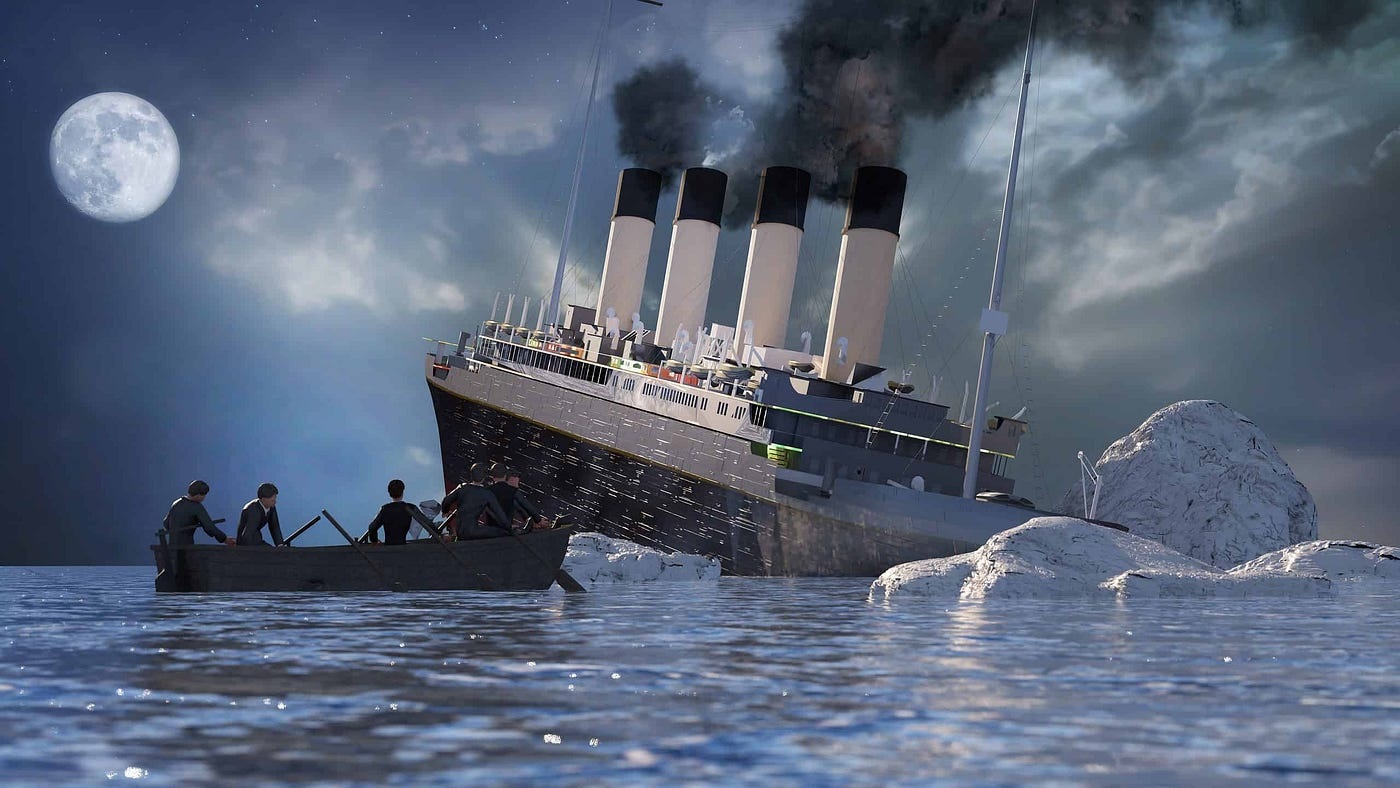The Titanic Disaster: A Tragic Tale of Hubris and Heroism

The Titanic Disaster: A Tragic Tale of Hubris and Heroism
In the annals of maritime history, few
events loom as large as the sinking of the RMS Titanic. This magnificent ocean
liner, touted as unsinkable, met its tragic fate on the night of April 14-15,
1912, resulting in the loss of over 1,500 lives. The Titanic's demise shocked
the world and sparked an enduring fascination with the ship and its ill-fated
maiden voyage. In this article, we delve into the captivating story of the
Titanic disaster, exploring its origins, the events leading up to the tragedy,
the heroic efforts of passengers and crew, the aftermath, and its enduring
legacy.
Origins
of the Titanic
The origins of the Titanic can be traced
back to the competitive atmosphere of the early 20th-century transatlantic
passenger trade. In the wake of the White Star Line's rival, Cunard, launching
the impressive Lusitania and Mauretania, White Star sought to regain prominence
by constructing a trio of luxury liners: Olympic, Titanic, and Britannic.
Designed by renowned naval architect Thomas Andrews, the Titanic was envisioned
as the pinnacle of maritime engineering, boasting unparalleled luxury and safety
features.
Construction of the Titanic began in March
1909 at the Harland and Wolff shipyard in Belfast, Northern Ireland. The ship's
design incorporated advanced safety features, including watertight compartments
and a double hull, intended to ensure its buoyancy and stability. However,
despite these innovations, the Titanic's fate would ultimately be sealed by a
fatal combination of human error, design flaws, and sheer misfortune.
The
Maiden Voyage
After years of anticipation and hype, the
Titanic set sail on its maiden voyage from Southampton, England, to New York
City on April 10, 1912. On board were over 2,200 passengers and crew, including
some of the wealthiest and most prominent individuals of the era. The
atmosphere on the ship was one of excitement and opulence, with passengers
marveling at the ship's luxurious amenities, fine dining, and state-of-the-art
facilities.
As the Titanic embarked on its
transatlantic journey, it attracted widespread attention and media coverage,
with newspapers hailing it as a triumph of human ingenuity and engineering.
However, lurking beneath the surface of this grandeur was a sense of overconfidence
and complacency among the ship's crew and passengers. The prevailing belief in
the Titanic's invincibility would soon be put to the ultimate test.
The
Tragedy Unfolds
On the night of April 14, 1912, the Titanic
struck an iceberg in the North Atlantic Ocean, approximately 400 miles south of
Newfoundland. The collision tore a series of large gashes in the ship's hull,
compromising multiple watertight compartments and causing the Titanic to
rapidly take on water. Despite the severity of the damage, many passengers
initially remained unaware of the gravity of the situation, believing the ship
to be unsinkable.
As the reality of the disaster became
apparent, chaos ensued aboard the Titanic. Lifeboats were launched, but in a
staggeringly inadequate manner, with many launching only partially filled. The
shortage of lifeboats, coupled with a lack of emergency preparedness and
coordination, exacerbated the loss of life. Women and children were given
priority access to the lifeboats, while many men were left behind to face the
sinking ship.
Acts
of Heroism and Sacrifice
Amidst the chaos and confusion, acts of
heroism and selflessness emerged among both passengers and crew. Stories abound
of individuals sacrificing their own safety to help others, whether by
assisting fellow passengers into lifeboats, searching for loved ones, or
offering comfort and reassurance in the face of impending disaster. The bravery
of the Titanic's musicians, who continued to play music to calm passengers as
the ship sank, became emblematic of the human spirit in the face of tragedy.
One notable example of heroism was that of
the ship's captain, Edward Smith, who remained on the bridge until the last
moments, directing efforts to evacuate passengers and maintain order. Smith's
actions, while commendable, were ultimately insufficient to avert the
catastrophe, and he went down with the ship.
Aftermath
and Legacy
The sinking of the Titanic sent shockwaves
around the world and prompted widespread scrutiny of maritime safety
regulations. Investigations into the disaster revealed a litany of
shortcomings, including inadequate lifeboat capacity, insufficient training of
crew members, and a lack of effective communication and coordination
procedures. In response to these findings, significant reforms were implemented
in the shipping industry, leading to the establishment of stricter safety
standards and the creation of international maritime regulations.
The Titanic disaster also had profound
social and cultural repercussions, symbolizing the hubris of the industrial age
and the fragility of human ambition. The sinking of the Titanic shattered the
prevailing belief in technological invincibility and highlighted the need for
humility and caution in the face of nature's power. The tragedy sparked a wave
of mourning and commemoration, with memorials erected in honor of the victims
and survivors.
Investigations
and Inquiries
In the wake of the Titanic disaster,
multiple investigations and inquiries were launched to ascertain the causes of
the tragedy and to assign responsibility for the loss of life. The United
States Senate convened a special subcommittee to investigate the circumstances
surrounding the sinking, leading to a series of hearings that scrutinized the
actions of the White Star Line, the ship's crew, and the adequacy of maritime
safety regulations.
Similarly, the British Board of Trade
conducted its own inquiry into the disaster, led by Lord Mersey. The inquiry
examined testimony from survivors, witnesses, and experts in maritime safety,
ultimately producing a comprehensive report that outlined the contributing
factors to the Titanic's sinking and made recommendations for improving
maritime safety standards.
Survivors
and Their Stories
Among the most compelling aspects of the
Titanic disaster are the stories of the survivors, whose firsthand accounts
provide invaluable insights into the events of that fateful night. Survivors'
testimonies offer vivid descriptions of the chaos and confusion aboard the
sinking ship, as well as the courage and resilience displayed by individuals in
the face of unimaginable adversity.
One of the most famous survivors of the
Titanic was Margaret "Molly" Brown, whose actions during the
evacuation earned her the nickname "The Unsinkable Molly Brown."
Brown played a prominent role in assisting fellow passengers into lifeboats and
organizing relief efforts aboard the rescue ship Carpathia. Her bravery and
compassion made her a symbol of hope and resilience in the aftermath of the
disaster.
The
Wreck of the Titanic
For decades after its sinking, the Titanic
lay undisturbed at the bottom of the North Atlantic, its resting place shrouded
in mystery and speculation. In 1985, a joint American-French expedition led by
Dr. Robert Ballard discovered the wreck of the Titanic, resting nearly 12,500
feet below the ocean's surface. The discovery of the Titanic's remains
reignited public interest in the disaster and provided researchers with
valuable insights into the ship's final moments.
Subsequent expeditions to the Titanic wreck
have yielded a wealth of artifacts and evidence, shedding light on the
conditions aboard the ship at the time of its sinking and the impact of the
disaster on its passengers and crew. The wreck site has become a protected
maritime memorial, visited by researchers, explorers, and tourists seeking to
pay their respects to the victims of the Titanic disaster.
Editor’s
Thoughts:
The sinking of the Titanic remains one of
the most enduring and poignant tragedies in maritime history, serving as a
stark reminder of the fragility of human life and the consequences of
overconfidence. The loss of over 1,500 souls aboard the "unsinkable"
ship shocked the world and sparked a legacy of remembrance and reflection. The
Titanic disaster continues to captivate the public imagination, inspiring
countless books, films, and documentaries, and serving as a timeless testament
to the indomitable spirit of those who perished and those who survived.



